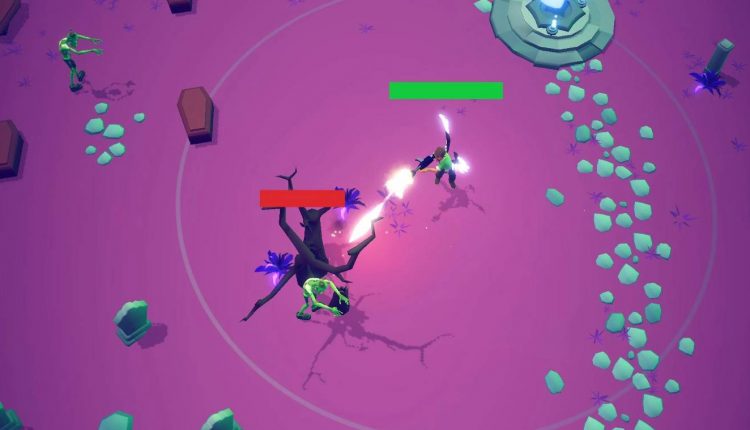Mystic Games CEO Matthew Buxton on how web3 gives players more freedom

This article first appeared on PocketGamer.biz.
Gaming has played a significant role in the web3 space, with decentralised aspects allowing studios to provide players with a chance of not just playing games but also owning parts of them along the way. Despite heavy expansion and investment in recent years, some web3 games have struggled to balance web3’s utility while delivering the fun factor players expect.
We caught up with Mystic Games CEO Matthew Buxton to find our more about its new game Call of the VoYd, the future potential of Web3 and we take a look at some past and present mistakes made in the Web3 space and how these issues can be overcome.
What was the original idea behind Call of the Voyd and why did it feel right to make it a web3 game?

Matthew Buxton: The idea behind Call of the VoYd was to shake up the rogue-lite/survivor genre by creating something with a competitive edge that also leans heavily into the ‘every run is different’ ethos.
We wanted to incorporate web3 elements because the tech allows us to experiment with creating prizes for competitive play, and we can include rare items that are verifiably limited. The bonus is that they will all be interoperable with future titles, and every player will essentially be able to sell or trade their account should they want to, without the grey market risk.
What can you tell us about the web3 gaming landscape?
There are definitely more people building web3 games than people playing them, but it is an exciting place at the moment. Unfortunately, games created as a financial vehicle with barely any game elements to speak of still exist, with the expectation that players have to buy something to even begin to play. In saying that, the space is moving forward and improving.
For me, I think the worst possible user experience for a mobile game is to have to go to an external and random marketplace to make a financial decision.
One current trend I’ve seen is for studios to say their priority is to ‘make fun games’ but then spend most of their time talking about staking, chains and ‘educating users’. I may be a little harsh, but I think it will be a while before we see this significantly evolving.
One current trend I’ve seen is for studios to say their priority is to ‘make fun games’ but then spend most of their time talking about staking, chains and ‘educating users’.
Matthew Buxton, Mystic Games
Call of the VoYd is on mobile. What potential does web3 offer mobile game developers?
As with any innovative evolving technology, incorporating Web3 elements takes time and experimentation.
One real advantage is building a community together that really cares about the game. It’s pretty cool to have a conversation with our community and build the game together; this gives us a real chance to make something they genuinely want.
We have an average of 14.2 sessions per user on our prototype, for example, which is a dedication you don’t see outside of Kickstarter.
Secondly, you can retain players in your ecosystem by including verified game assets and currencies. When you bring out your next game, existing players can pick up almost where they left off.
How do you balance web3 elements with the fun factor of the game?
We haven’t had to strike a balance – because it’s genuinely a fun game. My view is that web3 shouldn’t make itself known in the game. To us, web3 is a tech solution that allows players to take things they find in-game, out of the game and do what they like with them.
What do you think needs to happen within web3 to see broader adoption?
To be frank, the games need to be created without the premise of trying to make money from players selling or buying things within it. We need to stop applying constructs like staking, make games without marketplaces, and design NFTs that have some semblance of being able to work in games with 100k concurrent users. Developers need to stop focusing on making elements artificially expensive, as well as stop with the idea that everything can be modelled.
What are your plans for the future and where do you see web3 heading?
The beta for Call of the VoYd is coming out soon, called Call of the VoYd HeartlinerZ, and we have game two in the works already. We’re currently in the process of opening a new studio in Stockholm to finish production of it. In the short term, we’re heading to Token2049 in Singapore to spread some hot takes.
In the future, I believe web3 will be seen as exciting tech that allows players more freedom in how they play rather than a means to grind money out of users. As the space evolves, players will expect that items they own in games belong to them in a more tangible way, and developers will utilise Web3 technology to meet that expectation.
The space does have a bright future if game developers can overtake NFT hype projects and the first generation web3 ‘games’ – real developers with motives to build great games are coming.
Taking a user-oriented approach and ‘giving back’ to the players is how the industry grows. Just look at the difference between arcade and console. Arcade was pay to play – one game, one studio, no ownership. Console was ownership of the machine, multiple games, less exclusivity. This is the same with free to play mobile. We believe that if we reward players and give them something they might find value in, then they will play more – and so far, this is exactly what we’re seeing.
